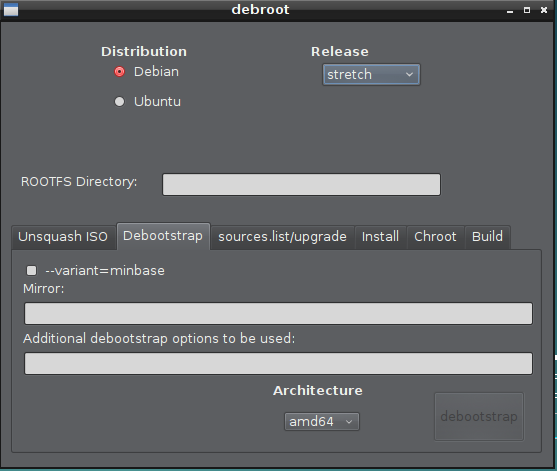An app that can:
- create (debootstrap) a debian or ubuntu system;
- run a shell in the chroot filesystem;
- create a live iso from the created chroot filesystem;
- unsquash, update and rebuild an existing ubuntu or debian and their derivatives live ISO image.
ATM the app does the following:
- selects and unsqhashes an Debian or Ubuntu Live iso file (content of chroot may be upgraded, see bellow) and can rebuild it;
- chroot APT sources.list can be edited, "apt-get update/upgrade/dist-upgrade" are a button click away;
- packages can be installed in the chroot by dropping their names in a textbox and clicking "Install";
- can create a bare minbase debootstrap of Ubuntu or Debian, and from that, create a very small Live ISO, or else one can add new repositories, install packages and then build the Live iso image;
- generates a script with all the commands that were executed to replicate the process on another host without debroot.
- To enable "Unsquash" button you may have to type and remove text in the "ROOTFS Directory" text input;
- Some buttons are disabled because they are not implemeted yet. It is the case of "build USB image" and "chroot RDP" buttons.
Also see TODO file.
- run scripts/hooks in chroot;
- support preseed files upon package install;
- build non-live USB image;
- add a custom script based installer to "replace" both ubiquity or debian-installer;
There are pre-built debian packages available at https://sourceforge.net/projects/debroot/.
One can also build a debian package from sources with:
dpkg-buildpackage -us -uc
Install it with gdebi:
sudo gdebi -o "APT::Install-Recommends=0" debroot_0.XX_all.deb -nq
From an installed debian package:
sudo debroot.pl
Unzip or git clone somewhere, then...
This is a perl QT app. To run it in debian/Ubuntu install:
sudo apt-get install libqtgui4-perl
From sources:
sudo ./debroot.pl
To develop install:
sudo apt-get install qt4-dev-tools
To update the GUI perl module after changes made in qt4-designer type:
make
Forum thread in debian.forums.net;
Forum thread in ubuntuforums.com;
- Select the distribution (Ubuntu or Debian) and select the release;
- If you have selected Ubuntu, on the Debootstrap tab, on the "Additional options" type "--components=main,universe" to allow to download some packages from there;
- Type the directory where the new chroot will be built in "ROOTFS directory";
- Click "Debootstrap" button and wait until it finishes;
- Click the "Build" tab. You will have a "Prepare ISO" button available while "Build ISO" is not. Click "Prepare ISO" and wait. Reply "Yes" to all package installs needed to make a Live system;
- After "Prepare ISO" is finished, the button "Build ISO" should now be available. Click it to build the Live iso of a chroot.
- Type the directory where the ISO chroot content will be extrated in "ROOTFS directory";
- Click the "Unsquash" tab, click "Select ISO" button to select an existing ISO;
- After the file is selected the button "Unsquash" should now be available. If not add and remove text in the "ROOTFS directory" to update the UI interface (its a bug);
- Click the "Unsquash" button and wait;
- Click the "sources.list/upgrade" tab. Click the button "Read" to load the existing "sources.list" present in the chroot. Click the "Update" button to run an "apt-get update" in the chroot;
- Click the "Upgrade" button to upgrade the content of the chroot, as a "apt-get upgrade" would do. Running "dist-upgrade" is not recommended, but available;
- Click the "Install" tab to install additional packages to the live image;
- After installing or upgrading the system, click the tab "Chroot" and then click the button "Chroot Shell";
- In the shell type "apt-get autoremove --purge" and "apt-get clean" to reduce the size of the resulting live image. Type "exit" to return to the app;
- Now click the "Build" tab and the button "Build ISO" should be available. Click it.
This is a workaround for Debian 7 Wheezy and 8 Jessie and testing/Stretch, while bug #820036 is not fixed for Debian 9 Stretch. It is only supported for 64 bit systems.
More info about this UEFI workaround see James Bottomley blog about it.
- Type the directory where the ISO chroot content will be extrated in "ROOTFS directory";
- Click the "Unsquash" tab, click "Select ISO" button to select an existing ISO;
- After the file is selected the button "Unsquash" should now be available. If not add and remove text in the "ROOTFS directory" to update the UI interface (its a bug);
- Click the "Unsquash" button and wait;
- Now click the "Build" tab and the button "Build ISO" should be available. Click it without unchecking the checkbox "UEFI enabled".
This app works with either ubuntu and debian and their derivatives. It was tested with the following distros:
- Ubuntu 16.04;
- Debian 7 and 8 (although Debian produces Live daily builds, one can install additional packages with debroot);
- Linux Mint (and LMDE2);
- Kali Linux 2016.1;
- TAILS 2.4;
- Sparkylinux 4.3;
- Debtailor 2016-1;
- In general this app should work with any live distro that uses either casper or debian-live.
This project is licensed under the terms of the GNU GPL v2 License.
(c) 2016 Rui Miguel P. Bernardo
Email: rui.bernardo.pt(at)gmail.com
